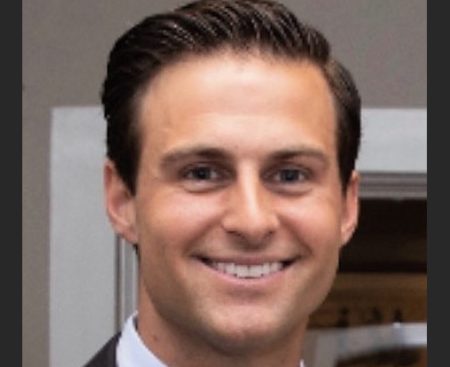The Sacred Triduum takes place during Holy Week, which is the most serious and wonderful week in Christianity, the peak of the liturgical year. The Easter Triduum occurs from the evening of Holy Thursday to the evening of Easter Sunday and is considered the most serious part of the liturgical year. The term “triduum” comes from Latin and basically means “three days” being “tri” (three) and “dies” (days). This term was used at the Second Vatican Council when the revised liturgical calendar was established, separating Holy Week from Lent. Previously, these three days were a time of quiet, and known as “the still days.” During Mass, there was no music and church bells were silent.
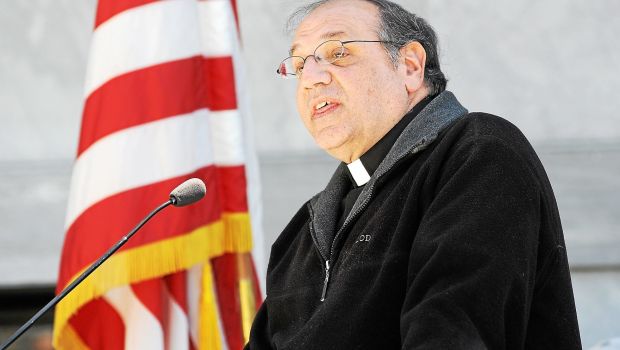
Rev. Gus Puleo, former pastor of St. Patrick’s Church in Norristown
On the evening of Holy Thursday, the Church commemorates the Mass of the Lord’s Supper, which remembers Christ’s Passover meal with his apostles the night before he died. This Mass celebrates the establishment of the Eucharist, the sacramental gift of the Church of Christ’s Body and Blood presented in the transformation of bread and wine. Also, in this Mass, there is the establishment of the priesthood which took place before Jesus was crucified. This happened in the Upper Room at the Last Supper, which was the first Mass, when Jesus said, “Do this in memory of me.” At that moment, the Apostles were transformed into the first priests as well as the first Bishops.
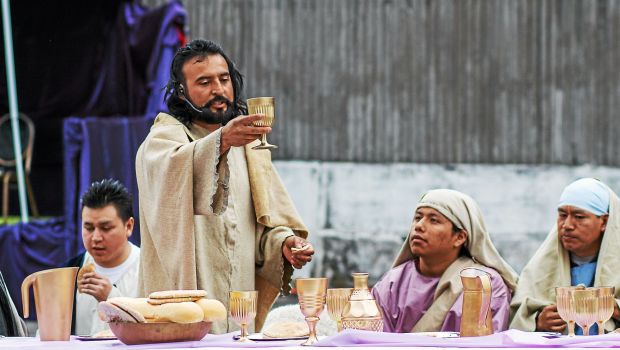
Jesus institutes the Eucharist at the Last Supper during the living Stations of the Cross presented at the Church of St. Patrick, Norristown, Good Friday, April 3, 2015.
During the Mass of the Lord’s Supper and after the sermon, the priest washes the feet of members of the congregation, remembering Christ washing the feet of his apostles. This foot washing signifies the priest’s role as a servant, just as Jesus did with his disciples — “If I, therefore, the master and teacher, have washed your feet. You ought to wash one another’s feet. I have given you a model to follow so that as I have done for you, you should also do.”
In the time of St. Ambrose in Milan, those who were baptized also had their feet washed, because of Jesus’s words to Peter: “Whoever has bathed has no need except to have his feet washed” (John 13:10). Many theologians see a baptismal reference in these words. Extra hosts are consecrated at the Mass of the Lord’s Supper to be used on Good Friday when no Mass will be celebrated. Holy Thursday is often called “Maundy Thursday” which comes from the Latin word “mandatum” which means “mandate.”
So, on this day Christ gave us this new mandate: “I give you a new commandment love one another. As I have loved you, so you also should love one another.” The Mass does not end. There is no dismissal or final blessing. After the Mass on Holy Thursday, the altar is stripped and all decorations are removed. The Blessed Sacrament is taken from the tabernacle on the main altar and processed to the “altar of repose,” a place where the consecrated Hosts are kept, away from the main altar where Mass is normally celebrated. The sanctuary candle or paschal candle is extinguished and darkened and not relit until the Easter Vigil. Many parishes will allow people to stay and pray before the reposed Eucharist at this altar of repose late into the night, remembering Jesus’ request in the Garden of Gethsemane for someone to “watch and pray” with Him. Also, in some churches images of the saints are either kept hidden or veiled until the Easter Vigil. Votive lights before these statues are not lit. Crucifixes are hidden and those that are not movable are veiled until the Easter Vigil.
On Good Friday, Catholics recall the suffering and crucifixion of Jesus Christ. It is a required day of fasting and abstaining from food. Mass is not conducted on this day, instead, a communion service is held, since Good Friday is the only day of the year when no Masses are offered. However, Holy Communion, which is kept in the tabernacle on the altar of repose, is shared at the Celebration of the Lord’s Passion. The ceremony typically takes place at 3 pm, marking the time of Jesus's death, and includes three parts: the Liturgy of the Word, the Veneration of the Cross, and Holy Communion.
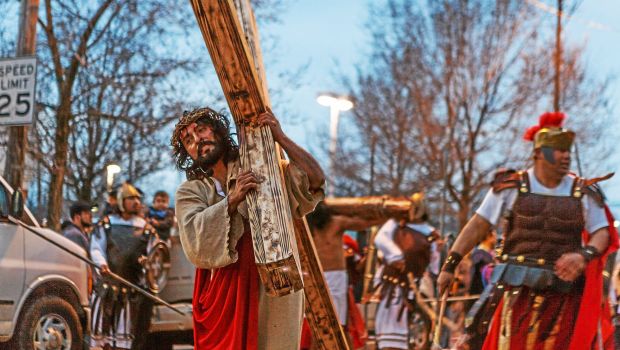
Jesus carries his burden during the living Stations of the Cross presented at the Church of St. Patrick, Norristown, Good Friday, April 3, 2015.
During the Liturgy of the Word, the account of Jesus's suffering and crucifixion is recounted. The second part involves the Veneration of the Cross, where each parishioner pays individual respect by kneeling before a cross and kissing it. The third part is Holy Communion, with the Eucharist having been consecrated at the Mass on Holy Thursday. At the end, the priest and people leave in silence and the altar cloth is taken away, leaving the altar bare.
On Holy Saturday, there are no daytime Masses. It is a day of fasting, reflection, and sorrow before the Easter Vigil begins in the evening. On this day, Christ is in the tomb. In the Apostles Creed, we pray “He descended into hell,” which is translated as “hades,” the temporary dwelling of the dead, not the eternal lake of fire. During this time, Jesus descended into this realm of the dead to save the righteous souls, such as Adam, Eve, and the Old Testament Patriarchs who died before the crucifixion. This was the final phase of Jesus’s messianic mission, during which he opened the gates of heaven for the just who came before him.
On this day, we should focus on the Blessed Mother and remember what happened on Good Friday. We should empathize with the Sorrowful Heart of Mary, who stood at the foot of the cross and experienced the Passion, suffering, and death of her son, Jesus Christ. On Good Friday and Holy Saturday, it is suggested that the priest and parishioners hold a communal celebration of the Office of Readings and Morning Prayer. The Office, formerly known as “Tenebrae,” was a special devotion where the faithful meditated on the passion, death, and burial of Christ, while anticipating the announcement of the Resurrection. The word “Tenebrae” means “shadows, gloom, and darkness.”
The Easter Vigil, held after nightfall on Holy Saturday, anticipates the celebration of the Resurrection of Jesus. This Mass consists of four parts. The first is the Service of the Lights, starting outside the church around a large fire. This fire symbolizes the radiance of the Risen Christ dispelling the darkness of sin and death. The Paschal candle is blessed and lit, and it will be used throughout the Easter Season, remaining in the church sanctuary during that time, before being used for baptisms and funerals throughout the rest of the year, as a reminder that Christ is the light of life.
After the candle is lit, the priest carries it through the dark church, chanting "Christ is our Light" three times, and the parishioners respond with "Thanks be to God." The baptized people then light their candles from the Paschal candle's flame. Once the procession reaches the altar sanctuary, the "Easter Proclamation" called the "Exultet" is sung, and the church is lit only by candlelight.
The second part of the Vigil involves the Liturgy of the Word, with seven readings from the Old Testament followed by a psalm and prayer. The readings connect the Old Testament to the Mystery of Jesus Christ. After the readings, the "Gloria" is sung for the first time since before Lent, except for Holy Thursday. The opening prayer is read, followed by the Epistle to the Romans and the chanting of Psalm 118. The "Alleluia" is sung for the first time since the beginning of Lent before the Gospel of the Resurrection is read.
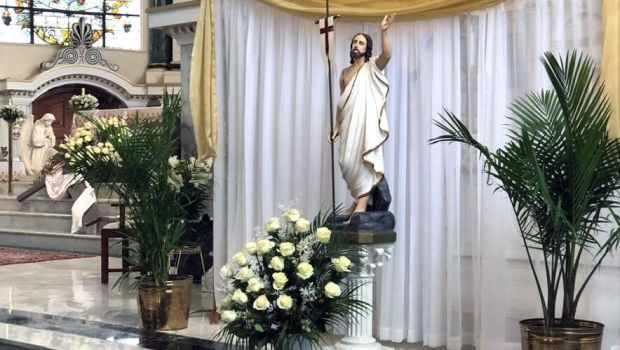
St. Patrick’s Church in Norristown celebrates the Risen Christ.
The third part is the Rite of Christian Initiation, in which people who want to become full members of the Church and have finished their formation can join. The Initiation celebration includes the Baptismal Liturgy, Confirmation, and renewal of Baptismal vows. Later during the Liturgy of the Eucharist, some receive their First Communion. On Easter Sunday, many Masses celebrate the Resurrection of Christ, and many people attend Mass celebrating the Victory of the Cross, by which we are saved through the suffering, death, and resurrection of Jesus Christ. It's suggested to attend some or all of these liturgies during the three days before Christ’s Resurrection.
The Rev. Gus Puleo is the director of the English as a Second Language (ESL) program and the Spanish Department at St. Charles Borromeo Seminary in Philadelphia, where he also teaches English and Spanish. He graduated from Norristown High School and attended Georgetown University, earning B.A. and B.S. degrees in Spanish and linguistics. He obtained master’s degrees in Spanish, linguistics, and divinity from Middlebury College, Georgetown University, and St. Charles Borromeo Seminary, and a Ph.D. in Spanish from the University of Pennsylvania. He previously served as the pastor of St. Patrick Church in Norristown.









